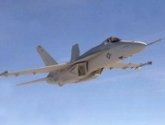
 The
F/A18-E/F Super Hornet is the US Navy's new long-range, multi-mission,
all-weather strike fighter. The aircraft made its debut at Patuxent
River (Md.) Naval Air Station in September 1995. A total of ten
test aircraft are being used for the test program. Seven are
flying test aircraft and three are ground test aircraft. All
seven flying aircraft are currently at Patuxent River.
The
F/A18-E/F Super Hornet is the US Navy's new long-range, multi-mission,
all-weather strike fighter. The aircraft made its debut at Patuxent
River (Md.) Naval Air Station in September 1995. A total of ten
test aircraft are being used for the test program. Seven are
flying test aircraft and three are ground test aircraft. All
seven flying aircraft are currently at Patuxent River.
The F/A18-E/F has achieved many milestones since its debut. The
most significant was initial sea trials aboard USS John C. Stennis
(CVN 74), the Navy's newest aircraft carrier. These first Super
Hornet carrier qualifications occurred in January 1997 off the
coast of Florida, and consisted of a series of tests including
catapult launches, arrested landings and various other system
evaluations conducted by flight deck crews.
Background
The F/A18-E/F is an evolutionary upgrade of the combat-proven
F/A18-C/D, built by an industry
team led by McDonnell Douglas, Northrop Grumman, General Electric
and Hughes. The upgrade provides a state of the art multi-mission
capability and decades of growth potential at one third to one
half the cost of a new aircraft design. Increased engine power
comes from the F414-GE-400, an advanced derivative of the Hornet's
current F404 engine family. The F414 produces 35 percent more
thrust and improves overall mission performance. The F414's nine-to-one
thrust-to-weight ratio is one of the highest of any modern fighter
engine. Enlarged air inlets provide increased airflow to the
engines.
The Super Hornet is fully capable to conduct both air-to-air
and air-to-ground combat missions. This includes air superiority,
day/night strike with precision-guided weapons, fighter-escort,
close air support, suppression of enemy air defenses, reconnaissance,
forward air control and refueling. The Super Hornet has greater
range/endurance, can carry a heavier payload, has enhanced survivability,
and a built-in potential to incorporate future systems and technologies.
Compares with the F/A18-C/D, the F/A18-E/F:
can fly up to 40% farther on a typical interdiction mission.
can remain on station 80% longer during a typical combat air
patrol scenario.
will be able to "bring back" approximately three times
the amount of unused ordnance to the ship.
has increased internal fuel capacity by 3600 pounds (33%)
has increased engine power
can extend of the mission radius by up to 40%
has additional weapon stations, now totaling 11
has increased surface area by 100 square feet (25%)
carries modified display mechanisms to include crew station features,
up-front controls and color CRT instrumentation
Nation of Orgin: USA
Constructor: McDonnell Douglas
Type: Carrier-borne multi-role strike fighter
Crew: One (two in F/A-18F)
Length: 60.3 feet / 18.5 meters
Height: 16 feet / 4.87 meters
Wingspan: 44.9 feet / 13.68 meters
Wing Area: 46.30 m²
Max t-o weight: 29932 kg / 66000 pounds
Engine: Two General Electric F414-GE-400 afterburning turbofans,
rated at 96 kN thrust each
Speed: Mach 1.8+
Ceiling: 18 240 m
Range: over 11 240 km
Armament: One 20mm M-61A1 Vulcan cannon; 11 hardpoints for external
ordinance, including AIM 9 Sidewinder, AIM 7 Sparrow, AIM-120
AMRAAM, Harpoon, Harm, Shrike, SLAM, SLAM-ER, Walleye, AGM-65
Maverick; Joint Stand-Off Weapon (JSOW); JDAM; bombs, mines and
rockets (Se image)